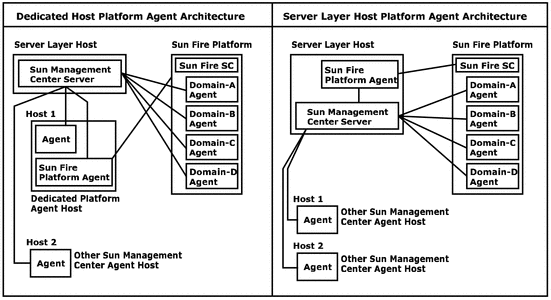Sun Fire Proxy/Platform Agent Resources
Sun Fire platform agents require a different installation procedure than standard Sun Management Center agents. Sun Fire platforms contain a number of domains, each domain with its own hardware allocation. Each domain runs a separate Solaris operating environment instance. Each of the Sun Fire domains runs a domain agent.
The Sun Fire platform as a whole consists of all the hardware in the platform allocated to the domains. The platform is controlled by a System Controller (SC) board within the platform.
To manage Sun Fire servers, Sun Management Center software uses Sun Fire platform agents that interact with the Sun Fire server system controller and Sun Fire domain agents. The platform agents must be deployed on a Solaris host external to the Sun Fire chassis that the agents are to monitor. Multiple platform agents can be deployed on a single host system to manage multiple Sun Fire servers, provided that the platform agent host system has been sized accordingly.
On average, each platform agent consumes 5% to 9% CPU and 15 to 18 Mbytes of memory. The CPU and memory consumption of platform agents deployed on the same host system are additive and can be used to gauge hardware requirements. The disk space requirements for multiple platform agent instances are minimally more than that for a single platform agent instance because the agents share the same software packages.
In general, the CPU and memory resource requirements of a platform agent are proportional to the size and complexity of the Sun Fire server configuration being managed. Sun Fire systems with larger configurations require more platform agent resources on the platform agent host.
System Requirements
You can install platform agents on either:
-
A Sun Management Center server layer host
-
A Sun Management Center dedicated platform agent host
The number of platform agents that can be installed on a given host varies depending on whether that host is a Sun Management Center server layer or platform agent layer host. To maximize the overall performance and responsiveness of Sun Management Center, platform agents should be deployed on dedicated hosts instead of the server layer host. If the server layer is deployed on a multiple CPU system with excess capacity, you can consider running platform agents on a server layer host.
The following figure shows the architecture for a dedicated platform agent host deployment, and a server layer host deployment.
Figure C–2 Platform Agent Architecture

Startup of Multiple Platform Agents
Sun Fire platform agents refresh their management information hourly by default. When multiple platform agents are deployed on the same host and are initialized at the same time, the agents tend to perform their data refreshes in quick succession. If too many platform agents attempt to refresh their data concurrently, the overall responsiveness of the host system can be adversely affected.
To reduce the likelihood of concurrent operations by multiple platform agents on the same host, do not start all of the platform agents at the same time.
Deploying Sun Fire Platform Agents on a Dedicated Host
The following table lists typical hardware configurations and the corresponding number of platform agents that can be deployed on the dedicated host system.
Table C–9 Dedicated Host: Sun Fire Platform Agent Capacity|
Representative Hardware Configurations |
Maximum Number of Platform Agents |
|---|---|
|
Sun Fire V120 with a single 650 MHz UltraSPARC IIe/i CPU, 2 Gbyte of RAM and 1 Gbyte of swap |
5 to 7 |
|
Sun Fire V440 with dual 1.2 GHz UltraSPARC III CPUs, 4 Gbytes of RAM and 1 Gbyte of swap |
14 to 20 |
Because platform agent resource use can vary, the limits shown in the table represent a range of acceptable values that leave sufficient capacity to ensure that operational peaks do not exhaust system capacity. Larger Sun Fire platforms require greater platform agent resources, with the result that fewer platform agents can be run on a single host. Conversely, smaller Sun Fire platforms require fewer platform agent resources, so more platform agents can be run on a single host.
Deploying Sun Fire Platform Agents on a Server Layer Host
The hardware sizing requirements of a host system running the Sun Management Center server layer are a function of the number of platform agents managed by the server layer and the management activity in the system.
Only large multiple-CPU systems should be considered for running both the Sun Management Center server layer and Sun Fire platform agents. The deployment of platform agents on a server layer host with limited capacity can adversely affect the overall performance of Sun Management Center.
Assuming a moderate level of management activity of fewer than 1000 events per host per day, the maximum number of platform agents than can be deployed on a Sun Management Center server layer host is the function of the number of agents under management and the machine class. The following table lists typical system capacity.
Table C–10 Server Layer Host: Sun Fire Platform Agent Capacity|
Number of Agents Under Management |
Maximum Number of Platform Agents |
|---|---|
|
100 |
6 |
|
300 |
5 |
|
500 |
4 |
|
750 |
NA |
Sun Fire 280R denotes a Sun Fire 280R, a Sun Blade 1000, or a Netra T4 system with a dual 750 MHz UltraSPARC III server host with 1 Gbyte of RAM and 1 Gbyte of swap.
For Sun Fire Sun Management Center installation procedures, see Sun Management Center Software Supplement for Sun Fire 6800/4810/4800/3800 Systems.
- © 2010, Oracle Corporation and/or its affiliates
